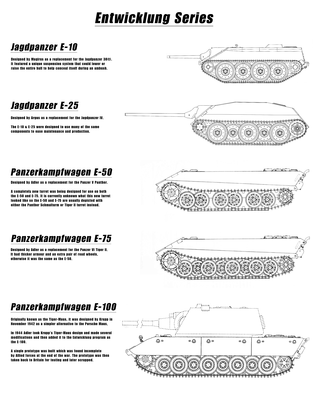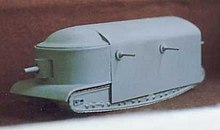
The Kliment Voroshilov (KV) tanks are a series of Soviet heavy tanks named after the Soviet defence commissar and politician Kliment Voroshilov who operated with the Red Army during World War II. The KV tanks were known for their heavy armour protection during the early stages of the war, especially during the first year of the German invasion of the Soviet Union. In certain situations, even a single KV-1 or KV-2 supported by infantry could halt German formations. The German Wehrmacht at that time rarely deployed its tanks against KVs, as their own armament was too poor to deal with the "Russischer Koloss" – "Russian Colossus".

Panzerkampfwagen VIII Maus was a German World War II super-heavy tank completed in July of 1944. It is the heaviest fully enclosed armored fighting vehicle ever built. Five were ordered, but only two hulls and one turret were completed, the turret being attached before the testing grounds were captured by advancing Soviet military forces.

The Char 2C, also known as the FCM 2C, was a French post WWI heavy tank landship, later considered a super-heavy tank. It was developed during World War I but not deployed until after the war. It was, in total volume or physical dimensions, the largest operational tank ever made.

The Turán tanks were a series of Hungarian medium tanks of World War II. They were produced in two main variants: the original 40M Turán with a 40 mm gun and later the 41M Turán with a short-barreled 75 mm gun, improved armour and a new turret. A total of 285 40M Turán I tanks were made. The 40M Turán was originally inspired by and used the features found on the design of the Czechoslovak Škoda T-21 medium tank prototype. The Turán tanks fought on the Eastern Front against the Soviets, and in the defence of Hungary.

Nazi Germany developed numerous tank designs used in World War II. In addition to domestic designs, Germany also used various captured and foreign-built tanks.

The Entwicklung series, more commonly known as the E-Series, was a late-World War II attempt by Nazi Germany to produce a standardised series of tank designs. There were to be standard designs in five different weight classes from which several specialised variants were to be developed. This intended to reverse the favor of extremely complex tank designs that had resulted in poor production rates and mechanical unreliability.

The Panzerkampfwagen VII Löwe (Lion) was a design for a super-heavy tank created by Krupp for the German government during World War II. The project, initially code-named VK 70.01 (K), never left the drawing board, and was dropped on 5–6 March 1942, in favor of Porsche's heavier Panzer VIII Maus.

The Char B1 was a French heavy tank manufactured before World War II.

Tanks were initially deployed in World War I, engineered to overcome the deadlock of trench warfare. Between the two world wars, tanks were further developed. Although they had demonstrated their battlefield effectiveness, only a few nations had the industrial resources to design and build them. During and after World War I, Britain and France pioneered tank technology, with their models generally serving as a blueprint for other countries. However, this initial advantage would slowly diminish during the 1930s, shifting in favor of the Soviet Union and, to a lesser degree, Nazi Germany.

The FCM F1 was a French super-heavy tank developed during the late Interbellum by the Forges et Chantiers de la Méditerranée (FCM) company. Twelve were ordered in 1940 to replace the Char 2C, but France was defeated before construction could begin, a wooden mock-up being all that was finished. The FCM F1 was large and elongated, and had two turrets: one in front and one in the back, with a single high-velocity gun in each turret. The rear turret was superfiring, meaning it was raised higher and fired over the top of the forward one, a common practice in naval vessels. The vehicle was intended to be heavily armoured. Its size and protection level made it by 1940, at about 140 tons, the heaviest tank ever to have actually been ordered for production. Despite two engines its speed would have been low. The primary purpose of the tank was to breach German fortification lines, not to fight enemy tanks. The development path of the FCM F1 was extremely complex, due to the existence of a number of parallel super-heavy tank projects with overlapping design goals, the specifications of which were regularly changed. For each project in turn several companies submitted one or more competing proposals.
The Landkreuzer P. 1000 "Ratte" was a design for a 1000-ton tank to be used by Germany during World War II which may have been proposed by Krupp director Edward Grote in June 1942, who had already named it "Landkreuzer". Submitted designs and drawings of the vehicle went under the names OKH Auftrag Nr. 30404 and E-30404/1, which were presented in December 1942. The tank was planned to be 1000 tonnes, far heavier than the Panzer VIII "Maus", the heaviest tank ever built. The project gained the approval of Adolf Hitler, who had expressed interest in the development of the tank but was cancelled by Minister of Armaments Albert Speer in early 1943.

The ARL 44 was a French heavy tank and tank destroyer, the development of which started just before the end of the Second World War. Only sixty of these tanks were ever completed, from 1949 onwards. The type proved to be unsatisfactory and only entered limited service. The tank was phased out in 1953.
The Char G1 was a French replacement project for the Char D2 medium tank. Several prototypes from different companies were developed from 1936 onwards, but not a single one had been fully completed at the time of the Fall of France in 1940. The projects represented some of the most advanced French tank design of the period and finally envisaged a type that would have been roughly equal in armament and mobility to later World War II standard tanks of other nations, such as the Soviet T-34 and the American M4 Sherman, but possessing several novel features, such as gun stabilisation, a semi-automatic loader and an optical rangefinder.
The Landkreuzer P 1500 Monster was a purported German pre-prototype super-heavy self-propelled gun designed during World War II. While it is mentioned in a number popular works about World War II projects, there is no solid documentation for the program’s existence, and it may have only been a semi-serious proposal, or even an outright hoax. Much like the Panzer IX and Panzer X.

The AMX-40 was a French main battle tank developed by GIAT during the latter stages of the Cold War as an export tank to replace the earlier AMX-32. Designed to be an inexpensive tank orientated towards militaries with smaller defence budgets, the AMX-40 featured a lightly armoured hull and good mobility reminiscent of previous French MBTs with a powerful 120 mm cannon. It however failed to attract interest and sales, rendering the project a failure, being discontinued in 1990.

The Panzerkampfwagen E-100 (TG-01) was a German super-heavy tank design developed towards the end of World War II. It was the largest of the Entwicklung series of tank designs which was intended to improve German armored vehicle production through standardization on cheaper, simpler to build vehicles. By the end of the war, the chassis of the prototype E-100 had been partially completed; it was shipped to the United Kingdom for trials, but was later scrapped.

The AMX 50 or AMX-50 is a French heavy tank designed in the immediate post Second World War period. It was proposed as, in succession, the French medium, heavy, and main battle tank, incorporating many advanced features. It was cancelled in the late 1950s however, due to unfavourable economic and political circumstances after serious delays in development.

This article deals with the tanks serving in the German Army throughout history, such as the World War I tanks of the Imperial German Army, the interwar and World War II tanks of the Nazi German Wehrmacht, the Cold War tanks of the West German and East German Armies, all the way to the present day tanks of the Bundeswehr.

French development into tanks began during World War I as an effort to overcome the stalemate of trench warfare, and largely at the initiative of the manufacturers. The Schneider CA1 was the first tank produced by France, and 400 units were built. The French also experimented with various tank designs, such as the Frot-Laffly landship, Boirault machine and Souain experiment. Another 400 Saint-Chamond tanks were manufactured from April 1917 to July 1918 but they were underpowered and were of limited utility because the caterpillar tracks were too short for the tank's length and weight. The most significant French tank development during the war was the Renault FT light tank, which set the general layout for future tank designs and was used or redesigned by various military forces, including those of the United States.
The AMX 38 was a prototype French tank designed in 1937 at the AMX works. Designed as AMX's response to the 20-tonne tank programme intended to replace the aging Char D2, it was a faster and heavier alternative to Renault R35, in practice a cross-over between a light tank and medium tank.


















